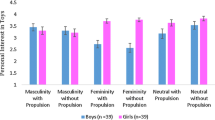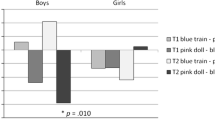Abstract
Three-year-old children were observed in two free-play sessions and participated in a toy-retrieval task, in which only one of six tools could be used to retrieve an out-of-reach toy. Boys engaged in more object-oriented play than girls and were more likely to use tools to retrieve the toy during the baseline tool-use task. All children who did not retrieve the toy during the baseline trials did so after being given a hint, and performance on a transfer-of-training tool-use task approached ceiling levels. This suggests that the sex difference in tool use observed during the baseline phase does not reflect a difference in competency, but rather a sex difference in motivation to interact with objects. Amount of time boys, but not girls, spent in object-oriented play during the free-play sessions predicted performance on the tool-use task. The findings are interpreted in terms of evolutionary theory, consistent with the idea that boys’ and girls’ play styles evolved to prepare them for adult life in traditional environments.
Similar content being viewed by others
References
Bates, E., V. Carlson-Luden, and I. Bretherton 1980 Perceptual Aspects of Tool Use in Infancy. Infant Behavior and Development 3:127–140.
Bateson, P. P. G. 1976 Rules and Reciprocity in Behavioural Development. In Growing Points in Ethology, P. P. G. Bateson and R. A. Hinde, eds. Pp. 401–421. Cambridge: Cambridge University Press.
Belsky, J., and R. Most 1981 From Exploration to Play. Developmental Psychology 17:630–639.
Berenbaum, S. A., and M. Hines 1992 Early Androgens Are Related to Childhood Sex-typed Toy Preferences. Psychological Science 3:203–206.
Bjorklund, D. F. 1997 The Role of Immaturity in Human Development. Psychological Bulletin 122:153–169.
Bjorklund, D. F., and R. D. Brown 1998 Physical Play and Cognitive Development: Integrating Activity, Cognition, and Education. Child Development 69:604–606.
Bjorklund, D. F., and A. D. Pellegrini 2000 Child Development and Evolutionary Psychology. Child Development 71:1687–1798.
2002 The Origins of Human Nature: Evolutionary Developmental Psychology. Washington, D.C.: American Psychological Association.
Bloch, M. N. 1989 Young Boys’ and Girls’ Play at Home and in the Community: A Cultural-Ecological Framework. In The Ecological Context of Children’s Play, M. N. Bloch and A. D. Pellegrini, eds. Pp. 121–154. Norwood, New Jersey: Ablex.
Bloch, M. N., and S. M. Adler 1994 African Children’s Play and the Emergence of the Sexual Division of Labor. In Children’s Play in Diverse Cultures, J. L. Roopnarine, J. E. Johnson, and F. H. Hooper, eds. Pp. 148–178. Albany: State University of New York Press.
Brown, A. 1990 Domain-Specific Principles Affect Learning and Transfer in Children. Cognitive Science 14:107–133.
Bruner, J. S. 1972 The Nature and Uses of Immaturity. American Psychologist 27:687–708.
Buss, D. M., and D. P. Schmidt 1993 Sexual Strategies Theory: An Evolutionary Perspective on Human Mating. Psychological Review 100:204–232.
Byrne, R. W. 1999 Cognition in Great Ape Ecology: Skill-Learning Ability Opens Up Foraging Opportunities. In Mammalian Social Learning: Comparative and Ecological Perspectives, H. O. Box and K. R. Gibson, eds. Pp. 333–350. Cambridge: Cambridge University Press.
Caldera, Y. M., A. M. Culp, M. O’Brien, R. Truglio, M. Alvarez, and A. C. Huston 1999 Children’s Play Preferences, Construction Play with Blocks, and Visual-Spatial Skills: Are They Related? International Journal of Behavioral Development 23:855–872.
Chen, Z., and R. S. Siegler 2000 Across the Great Divide: Bridging the Gap between Understanding of Toddlers’ and Older Children’s Thinking. Monographs of the Society for Research in Child Development 65(261).
Cheyne, J. A., and K. H. Rubin 1983 Playful Precursors of Problem Solving in Preschoolers. Developmental Psychology 19:577–584.
Christie, J. F., and E. P. Johnsen 1987 Reconceptualizing Constructive Play: A Review of the Empirical Literature. Merrill-Palmer Quarterly 33:439–452.
Collaer, M. L., and M. Hines 1995 Human Behavioral Sex Differences: A Role for Gonadal Hormones during Early Development? Psychological Bulletin 118:55–107.
Connolly, K., and M. Dalgleigh 1989 The Emergence of a Tool-using Skill in Infancy. Developmental Psychology 25:894–912.
Connor, J. M., and L. A. Serbin 1977 Behaviorally Based Masculine and Feminine Activity-Preference Scales for Preschoolers: Correlates with Other Classroom Behaviors and Cognitive Tests. Child Development 48:1411–1416.
Eibl-Eibesfeldt, I. 1989 Human Ethology. New York: Aldine de Gruyter.
Ellis, B. J., and D. F. Bjorklund, eds. 2005 Origins of the Social Mind: Evolutionary Psychology and Child Development. New York: Guilford.
Geary, D. 1998 Male, Female: The Evolution of Human Sex Differences. Washington, D.C.: American Psychological Association.
1999 Evolution and Developmental Sex Differences. Current Directions in Psychological Science 8:115–120.
2002 Sexual Selection and Human Life History. Advances in Child Development and Behavior 30:41–101. San Diego: Academic Press.
Geary, D. C., and D. F. Bjorklund 2000 Evolutionary Developmental Psychology. Child Development 71:57–65.
Geary, D. C., J. Byrd-Craven, M. K. Hoard, J. Vigil, and C. Numtee 2003 Evolution and Development of Boys’ Social Behavior. Developmental Review 23:444–470.
Geary, D. C., and M. V. Flinn 2001 Evolution of Human Parental Behavior and the Human Family. Parenting: Science and Practice 1:5–61.
Goodall, J. 1964 Tool-Using and Aimed Throwing in a Community of Free-Living Chimpanzees. Nature 201:1264–1266.
Gottlieb, G. 2000 Environmental and Behavioral Influences on Gene Activity. Current Directions in Psychological Science 9:93–102.
Hernández Blasi, C., and D. F. Bjorklund 2003 Evolutionary Developmental Psychology: A New Tool for Better Understanding Human Ontogeny. Human Development 46:259–281.
Hutt, C. 1966 Exploration and Play in Children. Symposia of the Zoological Society of London 18:61–81.
1972 Sex Differences in Human Development. Human Development 15:153–170.
Köhler, W. 1925 The Mentality of Apes. London: Routledge and Kegan Paul.
Lancy, D. F. 1996 Playing on the Mother-Ground: Cultural Routines for Children’s Development. New York: Guilford Press.
Leacock, E. 1976 At Play in African Villages. In Play—Its Role in Development and Evolution, J. S. Bruner, A. Jolly, and K. Sylva, eds. Pp. 466–473. New York: Basic Books.
Lockman, J. J. 2000 A Perception-Action Perspective on Tool Use Development. Child Development 71:137–144.
Lonsdorf, E. V., L. E. Eberly, and A. E. Pusey 2004 Sex Differences in Learning in Chimpanzees. Nature 428:16.
McGrew, W. C. 1992 Chimpanzee Material Culture: Implications for Human Evolution. Cambridge: Cambridge University Press.
Negussie, B. 1989 Health, Nutrition and Informal Education of Preschool Children in South West Ethiopia. Paper presented at the International Conference on Early Education and Development, Hong Kong.
Pellegrini, A. D., and D. F. Bjorklund 2004 The Ontogeny and Phylogeny of Children’s Object and Fantasy Play. Human Nature 15:23–43.
Pellegrini, A. D., and K. Gustafson 2005 Boys’ and Girls’ Uses of Objects for Exploration, Play, and Tools in Early Childhood. In Play in Humans and Great Apes, A. D. Pellegrini and P. K. Smith, eds. Mahwah, New Jersey: Erlbaum, in press.
Pellegrini, A. D., and P. K. Smith 1998 Physical Activity Play: The Nature and Function of Neglected Aspects of Play. Child Development 69:577–598.
Piaget, J. 1954 The Construction of Reality in the Child. New York: Basic.
1962 Play, Dreams, and Imitation. New York: Norton
Pitcher, E. G., and L. H. Schultz 1983 Boys and Girls at Play: The Development of Sex Roles. South Hadley, Massachusetts: Bergin and Garvey.
Poirier, F. E., and E. O. Smith 1974 Socializing Functions of Primate Play Behavior. American Zoologist 14:275–287.
Povinelli, D. J. 2000 Folk Physics for Apes: The Chimpanzee’s Theory of How the World Works. Oxford: Oxford University Press.
Roopnarine, J. L., J. E. Johnson, and F. H. Hooper, eds. 1994 Children’s Play in Diverse Cultures. Albany: State University of New York Press.
Rubin, K. H., G. Fein, and B. Vandenberg 1983 Play. In Handbook of Child Psychology 4:693–774. New York: Wiley.
Sandberg, D. E., and H. F. Meyer-Bahlburg 1994 Variability in Middle Childhood Play Behavior: Effects of Gender, Age, and Family Background. Archives of Sexual Behavior 23:645–663.
Sluss, D. J. 2002 Block Play Complexity in Same-Sex Dyads of Preschool Children. In Play and Culture Studies, J. L. Roopnarine, ed. Pp. 77–91. Conceptual, Social-Cognitive, and Contextual Issues in the Fields of Play, Vol. 4. Westport, Connecticut: Ablex.
Smilansky, S. 1968 The Effects of Sociodramatic Play on Disadvantaged Preschool Children. New York: Wiley.
Smith, P. K. 1982 Does Play Matter? Functional and Evolutionary Aspects of Animal and Human Play. Behavioral and Brain Sciences 5:139–184.
2005 Play: Types and Functions in Human Development. In Origins of the Social Mind: Evolutionary Psychology and Child Development, B. J. Ellis and D. F. Bjorklund, eds. Pp. 271–291. New York: Guilford.
Smith, P. K., and S. Dutton 1979 Play and Training in Direct and Innovative Problem Solving. Child Development 50:830–836.
Smitsman, A. W., and R. M. Bongers 2002 Tool Use and Tool Making: A Developmental Action Perspective. In Handbook of Developmental Psychology, J. Valsiner and K. J. Connolly, eds. Pp. 172–193. London: Sage.
Sutton-Smith, B. 1998 The Ambiguity of Play. Cambridge: Harvard University Press.
Sylva, K. 1977 Play and Learning. In Biology of Play, B. Tizard and J. P. Harvey, eds. Pp. 244–257. London: Heinemann.
Vandenberg, B. 1981 Play: Dormant Issues and New Perspectives. Human Development 24:357–365.
Want, S. C., and P. L. Harris 2001 Learning from Other Peoples’ Mistakes: Causal Understanding in Learning to Use a Tool. Child Development 72:431–443.
Whiten, A., J. Goodall, W. C. McGrew, T. Nishida, V. Reynolds, Y. Sugiyama, C. E. G. Tutin, R. W. Wrangham, and C. Boesch 1999 Cultures in Chimpanzees. Nature 399:682–685.
Willatts, P. 1985 Adjustment of Means-ends Coordination and the Representation of Spatial Relations in the Production of Search Errors by Infants. British Journal of Developmental Psychology 3:259–272.
1999 Development of Means-End Behavior in Young Infants: Pulling a Support to Retrieve a Distant Object. Developmental Psychology 35:651–667.
Author information
Authors and Affiliations
Corresponding author
Additional information
This research was conducted in partial fulfillment of a Master of Arts degree at Florida Atlantic University by the first author. Portions of this research were presented at the meeting of the Society for Research in Child Development, Tampa, FL, April, 2003.
Jeffrey M. Gredlein is a Ph.D. candidate in developmental psychology and an instructor at the University of North Carolina at Greensboro. His research interests are cognitive development, specifically problem solving in preschool children.
David F. Bjorklund is a professor of psychology at Florida Atlantic University. He is the author, with Anthony Pellegrini, of The Origins of Human Nature: Evolutionary Developmental Psychology (2002), and co-editor, with Bruce Ellis, of Origins of the Social Mind: Evolutionary Psychology and Child Development (2005). His research interests include cognitive development and evolutionary developmental psychology.
Rights and permissions
About this article
Cite this article
Gredlein, J.M., Bjorklund, D.F. Sex differences in young children’s use of tools in a problem-solving task. Hum Nat 16, 211–232 (2005). https://doi.org/10.1007/s12110-005-1004-5
Received:
Revised:
Issue Date:
DOI: https://doi.org/10.1007/s12110-005-1004-5




